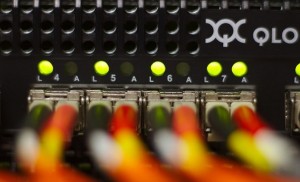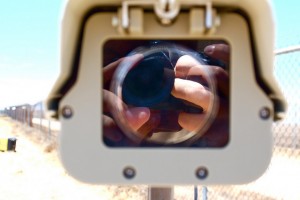 As a business owner protecting your facility is always a top concern. Are you getting the coverage you need? If you have a comprehensive security system you’re already in a good position. However, a security system is only as good as the sum of its parts. One of the most crucial parts of a security system is the surveillance aspect. Surveillance systems are the eyes that keep watch over your business even when you can’t.
As a business owner protecting your facility is always a top concern. Are you getting the coverage you need? If you have a comprehensive security system you’re already in a good position. However, a security system is only as good as the sum of its parts. One of the most crucial parts of a security system is the surveillance aspect. Surveillance systems are the eyes that keep watch over your business even when you can’t.
Like any other technology surveillance equipment is constantly evolving through research and development that is meant to improve its efficiency. In today’s IoT (Internet of Things) IP-based (Internet Protocol) systems are a driving force that is changing the role of surveillance in comprehensive security. But not everyone is so keen on the uptake. Prior to the inception of IP cameras and network devices the world was and has been dominated by analog cameras and DVR devices (Digital Video Recording). If you have existing surveillance equipment, chances are it’s a legacy analog system.
While the IP surveillance trend is picking up, there are still more than 40 million analog cameras in operation around the world today. Making the switch from analog to IP isn’t an easy transition for everyone and integrators have become increasingly aware. Fortunately there are hybrid solutions that allow you to work with your existing analog infrastructure and start your migration to an IP-based system. At Perfect Connections, Inc. our team of licensed integrators work with you to provide comprehensive security solutions that meet your needs. Our experts have been providing comprehensive security system solutions, including surveillance, to businesses throughout northern and central New Jersey for that past 23 years. We recognize the value technology adds to the security systems we install and how they can benefit our customers.
Why replace an analog system? To be fair, analog systems have filled a security need since the beginning of surveillance that would have otherwise gone unfulfilled. But just like any technology, progress is always pushing the envelope of what is relevant and effective. Look at smartphones, they are constantly evolving, every year a new model with new features that jettisons society forward. While businesses aren’t necessarily turning over their surveillance systems at the same rate, the growing trend is leaning towards IP and network based solutions.
Hybrid solutions for companies that aren’t ready to make the full switch to IP just yet offer the benefits of a more effective system that will ease the transition when the time is right. According to Mark Collett, general manager of Sony Security Systems Division, “With hybrid solutions, you can get the best of both worlds—the near-zero latency of analog plus IP’s HD imaging quality.”
Video encoders are the catalyst for the hybrid solution, replacing out of date and expensive DVRs. DVRs were traditionally responsible for storing and recording footage captured by connected surveillance cameras. According to James Marcella, a technologist in the security and IT industries, a video encoder is, “an open-platform technology that acts as a bridge between the analog and digital world by essentially turning an analog investment into IP cameras.” Video encoders would allow you to make use of existing infrastructure by attaching to the coaxial cable from you analog system, transforming the analog signal into a digital stream.
Many industry experts consider DVRs to be one of the most expensive pieces of equipment the consumer will purchase, and they are typically outlived by the analog cameras. Also, they are not dependable, if they go down so does the whole surveillance system, and this could happen at a critical moment. Video encoders are capable of running on power over Ethernet that can be tied to a backup power supply, keeping you covered no matter what. You can also employ redundancies like NAS devices (Network Attached Storage) and SD memory cards to help prevent recording loss.
DVRs lack the image resolution, edge intelligence, and network capabilities that a video encoder can offer. The frames per second rate (fps) is what creates a smoother clearer image, the higher the better especially in high motion scenarios. Video encoders are capable of capturing images at up to 60fps whereas DVRs only go up to 15fps. DVR intelligence is typically limited to whatever the manufacturer specifications have been set to. Video encoders open the door to third party intelligent applications which allow you to choose video management software from virtually any provider in the connected world. This creates a platform for advanced video analytics.
There is a large storage and scalability disparity between DVRs and video encoders. DVRs typically have a low tolerance for the quantity of cameras they can accommodate which can leave a business vulnerable by not being able to cover risky areas. On the other hand video encoders offer virtually limitless retention by being highly scalable. Video encoders have the ability to accommodate single cameras and there are some units that can accommodate up to 84 cameras making them a highly flexible and effective solution for a large or small facility.
The hybrid solution allows you to keep existing analog cameras and infrastructure and as the cameras die or warrant replacement, they can easily be swapped out for IP creating a smoother transition. Remote monitoring is another benefit to opting for a hybrid solution. This adds a level of security you can’t obtain from an analog system, being able to login to your surveillance system to see what is going on at your facility when you can’t be there.
Hybrid solutions are an economic and less disruptive option if you’re not fully committed to taking the IP plunge, even though progress will continue to push us in that direction. If you opt for a hybrid solution or aren’t sure what to do always consult a licensed professional to ensure proper application and installation. At Perfect Connections, Inc. our licensed integrators have been providing comprehensive security solutions to businesses throughout northern and central New Jersey since 1992. We can guide you through the process of creating a system that meets your specific needs, from an initial assessment to final installation.
If you live or run a business in Central or Northern New Jersey and would like information on any of the topics discussed above, please call 800-369-3962 or simply CLICK HERE.
Image Credit: Image by Mike Mozart-Flickr-Creative Commons

 Our world is constantly changing and evolving. Progression is an inevitable force that influences the way we live our daily lives. This is especially true of advancements made in the techy devices we interact with on a daily basis. Everything from our smartphones to our security systems. It’s the manner in how we interact with all of these devices that is driving innovation and product design. The internet and networking of devices is creating a connected environment that offers ultimate convenience and changes how we perceive the potential of security systems.
Our world is constantly changing and evolving. Progression is an inevitable force that influences the way we live our daily lives. This is especially true of advancements made in the techy devices we interact with on a daily basis. Everything from our smartphones to our security systems. It’s the manner in how we interact with all of these devices that is driving innovation and product design. The internet and networking of devices is creating a connected environment that offers ultimate convenience and changes how we perceive the potential of security systems. s a vital role in any comprehensive security system. It helps authorities catch criminals and provides helpful insight into your business operations by collecting and analyzing data on a daily basis. Where and how is all of this visual and analytical data being “collected?” That is the ever pressing question for system integrators and end-users alike. Storing surveillance data can be as important to the efficiency of your security system as having the surveillance equipment itself. We are catapulting ourselves into the future with the constant evolution of technology in all aspects of life including security system components, and surveillance storage solutions are no exception, but not all are created equal.
s a vital role in any comprehensive security system. It helps authorities catch criminals and provides helpful insight into your business operations by collecting and analyzing data on a daily basis. Where and how is all of this visual and analytical data being “collected?” That is the ever pressing question for system integrators and end-users alike. Storing surveillance data can be as important to the efficiency of your security system as having the surveillance equipment itself. We are catapulting ourselves into the future with the constant evolution of technology in all aspects of life including security system components, and surveillance storage solutions are no exception, but not all are created equal. When it comes to security systems you may have heard the term “edge technology,” “edge analytics,” or “edge devices.” What exactly do these terms mean and why are they important? When talking about security systems “the edge” is typically used when referring to video surveillance components. Every security system integrator and industry professional will likely have their own definition of what it means, but in summary “edge technology” refers to surveillance devices that operate, analyze, and record at their source versus transmitting all that information over a network to the system’s core. In traditional surveillance systems there is a central server where recorded data from peripheral devices is stored and analyzed. In an edge-based system cameras perform these functions locally.
When it comes to security systems you may have heard the term “edge technology,” “edge analytics,” or “edge devices.” What exactly do these terms mean and why are they important? When talking about security systems “the edge” is typically used when referring to video surveillance components. Every security system integrator and industry professional will likely have their own definition of what it means, but in summary “edge technology” refers to surveillance devices that operate, analyze, and record at their source versus transmitting all that information over a network to the system’s core. In traditional surveillance systems there is a central server where recorded data from peripheral devices is stored and analyzed. In an edge-based system cameras perform these functions locally. Does your security system, or part of it, rely on your company’s internet network? Or are you considering a system that is at least partially dependent on network connectivity? If so, what happens if that network fails or is compromised? Fortunately nowadays the chances of your network dropping or losing connection is pretty slim, in fact the probability of most Internet Service Providers (ISPs) experiencing an outage is about
Does your security system, or part of it, rely on your company’s internet network? Or are you considering a system that is at least partially dependent on network connectivity? If so, what happens if that network fails or is compromised? Fortunately nowadays the chances of your network dropping or losing connection is pretty slim, in fact the probability of most Internet Service Providers (ISPs) experiencing an outage is about  The images above show the difference between a parking garage being monitored by a camera with no WDR or WDR turned off on the left, and on the right the same area monitored by a camera with WDR enabled. The difference is clear as day. Why do they differ so much? The camera with the WDR enabled has two internal Charge-Coupled Devices (CCD). The two devices, or sensors, scan an image at different speeds, one low and one high, the image processor then combines the separate images producing a clearer, more balanced picture with better contrast and lighting. This process happens quickly enough to produce a stream of clear recorded footage. There are many different manufacturers that produce these WDR cameras in the market today, and not all of them use the same type of sensor and image processing combinations. The best way to ensure you are getting the best camera for your specific application is to hire a licensed security systems integrator who is educated in which camera specifications will work best in variant conditions.
The images above show the difference between a parking garage being monitored by a camera with no WDR or WDR turned off on the left, and on the right the same area monitored by a camera with WDR enabled. The difference is clear as day. Why do they differ so much? The camera with the WDR enabled has two internal Charge-Coupled Devices (CCD). The two devices, or sensors, scan an image at different speeds, one low and one high, the image processor then combines the separate images producing a clearer, more balanced picture with better contrast and lighting. This process happens quickly enough to produce a stream of clear recorded footage. There are many different manufacturers that produce these WDR cameras in the market today, and not all of them use the same type of sensor and image processing combinations. The best way to ensure you are getting the best camera for your specific application is to hire a licensed security systems integrator who is educated in which camera specifications will work best in variant conditions. The technological climate is swiftly changing the way we connect and interact with the physical world. Endless runs of cable and spaghetti wiring is becoming an antiquated notion with the development of wireless internet based equipment. This is evident in the way some security system integrators are approaching system design and installation. As industry professionals, our team at
The technological climate is swiftly changing the way we connect and interact with the physical world. Endless runs of cable and spaghetti wiring is becoming an antiquated notion with the development of wireless internet based equipment. This is evident in the way some security system integrators are approaching system design and installation. As industry professionals, our team at  Whether you are installing a new surveillance system or changing an existing one you need to consider the type of system and the operating implications associated with it. The desire for advanced image quality, video analytics, ease of integration, and remote access has ushered in the era of IP (Internet Protocol) surveillance systems. IP surveillance systems have opened the door to a more integrated security system and they provide increased scalability which is important to company growth and future adaptation. This type of surveillance system typically relies on an internet network, and as they say “therein lies the rub.”
Whether you are installing a new surveillance system or changing an existing one you need to consider the type of system and the operating implications associated with it. The desire for advanced image quality, video analytics, ease of integration, and remote access has ushered in the era of IP (Internet Protocol) surveillance systems. IP surveillance systems have opened the door to a more integrated security system and they provide increased scalability which is important to company growth and future adaptation. This type of surveillance system typically relies on an internet network, and as they say “therein lies the rub.”